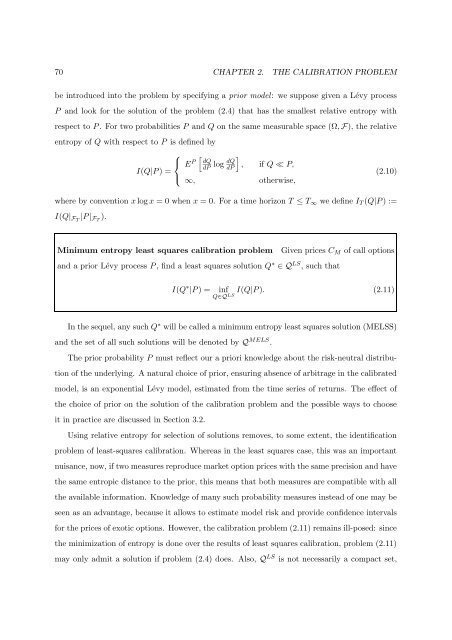Processus de Lévy en Finance - Laboratoire de Probabilités et ...
Processus de Lévy en Finance - Laboratoire de Probabilités et ...
Processus de Lévy en Finance - Laboratoire de Probabilités et ...
Create successful ePaper yourself
Turn your PDF publications into a flip-book with our unique Google optimized e-Paper software.
70 CHAPTER 2. THE CALIBRATION PROBLEM<br />
be introduced into the problem by specifying a prior mo<strong>de</strong>l: we suppose giv<strong>en</strong> a Lévy process<br />
P and look for the solution of the problem (2.4) that has the smallest relative <strong>en</strong>tropy with<br />
respect to P . For two probabilities P and Q on the same measurable space (Ω, F), the relative<br />
<strong>en</strong>tropy of Q with respect to P is <strong>de</strong>fined by<br />
⎧ [ ]<br />
⎨ E P dQ dQ<br />
dP<br />
log<br />
dP<br />
, if Q ≪ P,<br />
I(Q|P ) =<br />
⎩<br />
∞, otherwise,<br />
(2.10)<br />
where by conv<strong>en</strong>tion x log x = 0 wh<strong>en</strong> x = 0. For a time horizon T ≤ T ∞ we <strong>de</strong>fine I T (Q|P ) :=<br />
I(Q| FT |P | FT ).<br />
Minimum <strong>en</strong>tropy least squares calibration problem<br />
Giv<strong>en</strong> prices C M of call options<br />
and a prior Lévy process P , find a least squares solution Q ∗ ∈ Q LS , such that<br />
I(Q ∗ |P ) =<br />
inf I(Q|P ). (2.11)<br />
Q∈QLS In the sequel, any such Q ∗ will be called a minimum <strong>en</strong>tropy least squares solution (MELSS)<br />
and the s<strong>et</strong> of all such solutions will be <strong>de</strong>noted by Q MELS .<br />
The prior probability P must reflect our a priori knowledge about the risk-neutral distribution<br />
of the un<strong>de</strong>rlying. A natural choice of prior, <strong>en</strong>suring abs<strong>en</strong>ce of arbitrage in the calibrated<br />
mo<strong>de</strong>l, is an expon<strong>en</strong>tial Lévy mo<strong>de</strong>l, estimated from the time series of r<strong>et</strong>urns. The effect of<br />
the choice of prior on the solution of the calibration problem and the possible ways to choose<br />
it in practice are discussed in Section 3.2.<br />
Using relative <strong>en</strong>tropy for selection of solutions removes, to some ext<strong>en</strong>t, the i<strong>de</strong>ntification<br />
problem of least-squares calibration. Whereas in the least squares case, this was an important<br />
nuisance, now, if two measures reproduce mark<strong>et</strong> option prices with the same precision and have<br />
the same <strong>en</strong>tropic distance to the prior, this means that both measures are compatible with all<br />
the available information. Knowledge of many such probability measures instead of one may be<br />
se<strong>en</strong> as an advantage, because it allows to estimate mo<strong>de</strong>l risk and provi<strong>de</strong> confi<strong>de</strong>nce intervals<br />
for the prices of exotic options. However, the calibration problem (2.11) remains ill-posed: since<br />
the minimization of <strong>en</strong>tropy is done over the results of least squares calibration, problem (2.11)<br />
may only admit a solution if problem (2.4) does. Also, Q LS is not necessarily a compact s<strong>et</strong>,
















